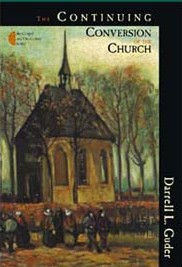 What is mission? Is it the same as evangelism? How do we engage in the Christian gospel in new contexts, whether they be the contexts of ethnic groups or generational cohorts? Darrell Guder’s book, The Continuing Conversion of the Church, provides useful frameworks for exploring these questions. This book, published in 2000, builds on the work of Lesslie Newbigin and the Gospel and Our Culture Network.
What is mission? Is it the same as evangelism? How do we engage in the Christian gospel in new contexts, whether they be the contexts of ethnic groups or generational cohorts? Darrell Guder’s book, The Continuing Conversion of the Church, provides useful frameworks for exploring these questions. This book, published in 2000, builds on the work of Lesslie Newbigin and the Gospel and Our Culture Network.
Guder starts by founding his approach to mission in a Trinitarian understanding of the nature of God – a God who reaches out – a missionary God so to speak. Thus the term, “Missio Dei” – the mission of God. Guder quotes Martin Kahler as saying, “Mission is the mother of theology”.
One way of describing mission is focusing on the gospel. “The gospel is the person and work of Jesus as the salvation event toward which God’s mission has been moving and from which that mission now moves into the entire world.”
A key part of mission then is being witness to the gospel. Showing his true Reformed colours Guder tells us that this witness will be theocentric, Christocentric, historical, eschatalogical, ecclesiological, multicultural and ecumenical. Don’t worry – read the book and you’ll get an idea of what he’s talking about!
Task of Translation
Having laid the theological foundations of mission, Guder goes on to the task of translation. He grounds this task in the risk that God has taken in allowing Godself to be expressed in human forms. Every time an aspect of God’s nature is expressed in language there is a risk that it will be misunderstood, warped, or even lost. God continues to take that risk in dealing with the people of Israel. God takes the risk of incarnation in Jesus, a particular man living in a particular Mediterranean ethnic group. God takes the risk in allowing the good news to be expressed in many languages, as in the experience of the early church at the festival of Pentecost.
Guder tells us that drawing back from the risk of translation is tantamount to the sin of control. Letting go of our control is taking part in God’s risky business. It will always involve our ongoing conversion as the church as each translation of the gospel reveals dimensions of good news not seen before.
“The apostolic ministry of witness takes place in a plurality of forms. None of them is normative for the others. But they are essential to each other as mutual affirmation, correction and challenge. They are all complementary in that they all respond to the same story, proclaim the same Christ, and pursue the implications of the same gospel in their various particular settings. No particular cultural rendering of the gospel may claim greater validity than any other, and all cultural formulations of the faith are subject to continuing conversion as the gospel challenges them.”
Guder warns us that Western Christianity has assumed it represented the cultural perfection of the gospel. There has been an assumption that the good news is spread through diffusion rather than translation. Guder reminds us that the good news of Jesus needs to be translated for emerging sub cultures. We need to engage in cultures other than our own, becoming bilingual if not multi-lingual. In the words of Hauerwas and Willimon, we need to be resident aliens, without ghettoizing.
Hazards of Reductionism
Guder writes that worship services need to be seen as missionary events, invitations to follow Christ. To take that challenge seriously implies the continuing conversion of the church in its forms of worship.
It’s here that Guder explores the hazards of ‘reductionism’. Gospel reduction is unavoidable in the process of translation. But when we become absolutist in our understanding of the gospel, monopolising control of translation, we end up in reductionism. Guder warns his readers that making one form of Christianity normative leads to distortion.
Early forms of reductionism in the church include
- The first century church allowing itself to become one more religion within a multiplicity of religions.
- The transition from a movement to institution.
- The inability to make Jews feel at home, the loss of Jewish roots
Christendom forms of reductionism include:
- Shifting away from the event character of the gospel to the formulation of a defined faith system with a focus on truth and systematic theology.
- The Kingdom of God shifting into post-death eternity
- Salvation becoming an asset or commodity held by individual Christians
- Christian activity understood as disciplines of Christian behaviour that would prepare one for heaven
- The Church becoming the mediator/manager of salvation.
Reformation/Modernity forms of reductionism include:
- An over emphasis on the sovereign and initiating action of God
- Focusing on individual salvation
- Ignoring or minimalising the church’s mission
- Adoption of ’cause and effect’ approaches to education and evangelism
Current forms of reductionism include:
- Church leaders/clergy focus on managing individual salvation.
- Protestant restriction of preaching and administration of sacraments to ordained clergy
- Baptism focusing on individual salvation rather than a call to ministry
- Worship becoming an end in itself rather than God’s divine preparation for sending
- Evangelistic preaching focusing on happiness
- Serving public order, institutional security and protection of power
Role of Local Congregation
Guder goes on to explore the role of the local congregation. He reminds us that there is no normative way to form local congregations. We need to be careful not to blur evangelization and new member recruitment. We are recruiting people to the mission of God, not to the development of our particular local institution or power base! As we commission our members, it should not be to attend worship events or to fund our activity. We commission our members to engage in the mission of God in their environment, in most cases interpreting the good news for their particular culture, outside the control of the church institution.
“Evangelisation as the heart of ministry means that the gospel-centred community continually encounters and celebrates Christ. This is the purpose and witness of public worship. Evangelisation as the heart of ministry happens as Christ commissions the community to be his witnesses, to do his witness, and to say his witness. Continuing conversion is to Christ’s salvation and thus to his mission.”
Darrell goes on to explore practical ways in which local congregations and broader Christian institutions can engage in continuing conversion. It’s worth a read!
About Darrell Guder
 Darrell Guder is Henry Winters Luce Professor of Missional and Ecumenical Theology at Princeton Theological Seminary. An ordained Presbyterian minister, Guder was previously:
Darrell Guder is Henry Winters Luce Professor of Missional and Ecumenical Theology at Princeton Theological Seminary. An ordained Presbyterian minister, Guder was previously:
Professor of Mission and Evangelism at Louisville Presbyterian Theological Seminary, Professor of Evangelism and Church Growth at Columbia Theological Seminary, Student outreach pastor/faculty member at Karlshoehe College in Germany, Minister of Christian education at First Presbyterian Church Hollywood, Director of Institute of Youth Ministries with Fuller Theological Seminary/Young Life, and Vice president for academic affairs & dean of the faculty of Whitworth College in Spokane, Washington.
Darrell is the author of:
(co-editor) Missional Church: A Vision for the Sending of the Church in North America, Eerdmans, 1998
Be My Witnesses: The Church’s Mission, Message, and Messengers, Eerdmans, 1985
The Incarnation and the Church’s Witness, Trinity Press, 2000
